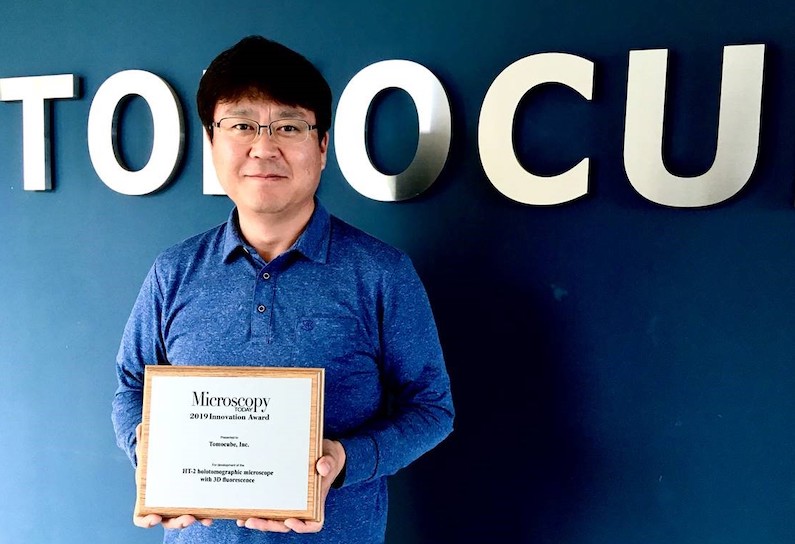Members Login

Channels
Special Offers & Promotions
Tomocube wins Innovation Award for HT-2 microscope
Development of the world’s first holotomographic microscope with 3D fluorescence recognised as photonics breakthrough by the 2019 Microscopy Today Innovation Award
Disruptive technology that combines the quantitative phase imaging (QPI) approach of label-free 3D refractive index (RI) tomography with fluorescence imaging to reveal the structure, volume, surface area, concentration, and dry matter mass of individual live cells in real-time has won the Microscopy Today 2019 Innovation Award.
The award recognises the photonics breakthrough inherent in the development of the Tomocube HT2 holotomographic microscope. Released earlier this year, the HT2 is the world’s first microscope to combine both holotomography and 3D fluorescence imaging into one unit. Capable of simultaneously capturing high resolution 3D optical diffraction tomography and 3D fluorescence images, the new microscope enables long-term tracking of specific targets in live cells while minimising stress. The capability to easily deliver holotomography and fluorescence correlative analysis in 2D, 3D and 4D will enable researchers and clinicians to open new frontiers in bioscience and better understand, diagnose, and treat disease.
The new microscope builds on the novel holotomographic technology first shown in the Tomocube HT-1, providing morphological, chemical and mechanical properties of cells through the 3D refractive index (RI) tomograms but adding molecular specificity information through the fluorescence imaging capability. The highly detailed fluorescence images show the position of specific target organelles or structures in living cells, while consecutive measurements of time-lapse 3-D RI tomography enables the monitoring of cells and their structures with minimal stress.
The HT-2 incorporates a customisable three-channel LED light source (385, 470 and 570 nm) and a motorized Z-drive with a step resolution of 150 nm to generate highly detailed Z-stack images. The TomoStudio software suite controls all the functionality of the HT-2 and provides fast imaging capability and 2D/3D/4D visualization of the cellular images based on 3D RI distributions of the cells and tissues. At its core is the same patented complex digital micromirror device (DMD) optical light shaper used in the Tomocube HT-1. Consisting of several hundred thousand micromirrors arranged in a rectangular array, the DMD eliminates the need for moving parts in the lightpath and delivers stable performance during long-term studies.
Benefits
- Correlative microscopy in one instrument - HT-2 provides high-quality 3D images of both holotomography and 3D fluorescence for each sample.
- Quantitative data marked with fluorescence - HT-2 provides morphological (volume, surface area, projection area, sphericity and ellipticity), chemical (dry mass, concentration) and mechanical (cell deformability) properties of cells with 3D refractive index (RI) tomogram. Moreover, fluorescence image provides information about molecular specificity.
- Live cell molecular and holographic imaging with minimal stress on cells - Simultaneous measurement capability of time-lapse 3-D RI tomography and fluorescence image allows long-time tracking of specific targets in live cells. The fluorescence image provides the position of specific target organelles or structures in live cell, and consecutive measurements of time-lapse 3-D RI tomography enables the monitoring of cells and their structures with minimal stress.
About Tomocube, Inc.
Tomocube is dedicated to delivering products that can enhance biological and medical research via novel optical solutions that can assist in understanding, diagnosing, and treating human diseases. Our microscope platform enables researchers to measure nanoscale, real-time, dynamic images of individual living cells without the need for sample preparation through the measurement of 3D refractive index tomograms. This enables researchers and clinicians to work with primary cells and non-invasively observe label-free 3D dynamics of live cells and tissues, make quantitative measurements and retrieve unique cell properties such as cell volume, cytoplasmic density, and surface area.
Media Partners



